4: The Early Renaissance (1400s)
( \newcommand{\kernel}{\mathrm{null}\,}\)
Florentine Renaissance
During the Renaissance, we encounter artists with personalities ranging from the sophisticated and urbane Leonardo da Vinci to the difficult and explosive personalities of Filippo Brunelleschi and Donatello. Michelangelo, arguably the greatest artist of his time, had a personality described as terribleness. He did not enjoy the company of fools, and certainly would not tolerate their presence. Despite their difficult and temperamental personalities, these gifted artists found patrons who would guide and support them through the challenges of creating some of the greatest masterpieces in western art.
We find some of the first patrons during the early Renaissance in Florence, Italy. One family in particular gives us major patrons through several generations. This family rises from humble beginnings to become the most powerful family in all of Europe. Doing business as a furrier while running a small banking operation from the back of the shop, Giovanni di Bicci de' Medici (c. 1360 – February 1429) makes a bet on a pirate. Knowing that there is instability surrounding the pope and his cadre of cardinals, Giovanni funds the pirate Baldassarre Cossa all the way up to the papacy itself. In doing so, Giovanni places his small bank in a position to become the Chief Papal Banker. Once the pirate assumes the role of pope, he remembers and rewards the Medici bank for funding his rise to the papacy.
With this partnership with the Vatican established, and the death of his father, Giovanni, Cosimo de’Medici assumes the leadership role of the Medici family and bank, and at this point, is himself one of the richest men in Europe. Cosimo will also continue working relationships established by his father with both sculptors Filippo Brunelleschi and Donatello. One way to further the Medici brand within both Florence and the surrounding region is to take a leadership role within the community itself. This was a challenge for Cosimo, since his family was not an established knighted family as many families in Florence were at that time. His father had always said to “wait to be summoned” by the political leaders and had stayed out of politics Cosimo certainly had challengers to his sudden rise to power within the Florentine political arena. However, through both luck and political savvy, Cosimo survives imprisonment and even a death penalty to live another day. At one point, he is banished from Florence, but returns with a glorious welcome after Florence flounders under the incompetent rule of his competitors. After he is welcomed back, Cosimo takes revenge on those who wished his demise. Revenge at that time was often violent, such as slicing the face of a rival. Doing this is often referred to as “a loss of face,” since the outcome is a permanent scar across the face. Cosimo plays a vital role at the start of the Renaissance in Florence. Not only is Cosimo a capable leader, but he also partners with some of the greatest artists of his time. He is interested in the ancient writings of the Greeks and Romans as well as any other interesting or useful information that can be uncovered from the vaults of the churches and cathedrals in and around Florence. With the support of the local clergy, he is able to access some of the ancient writings that have been stored away for hundreds of years. Not only does he access these ancient texts, but he also funds major commissions for architects, sculptors, and painters.
Brunelleschi
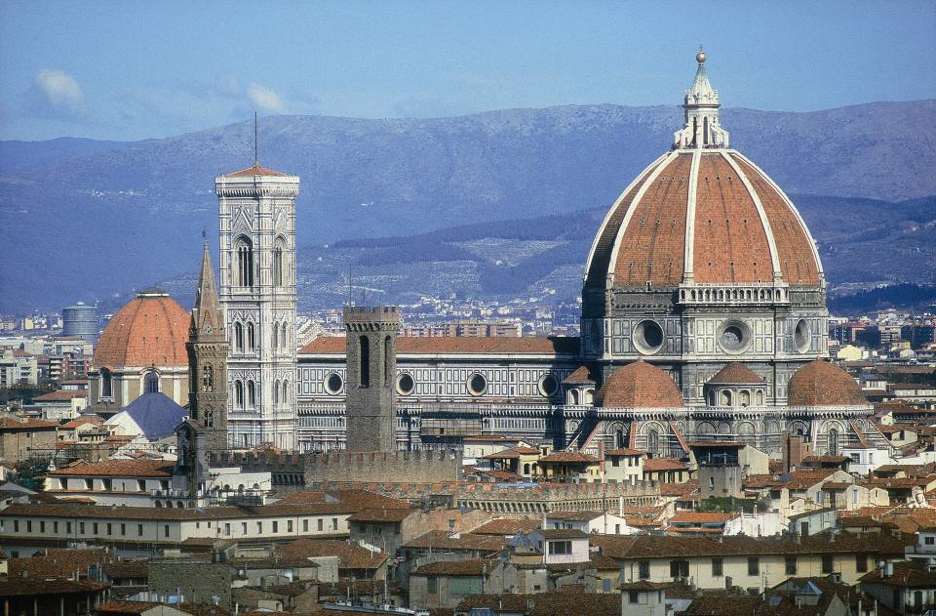
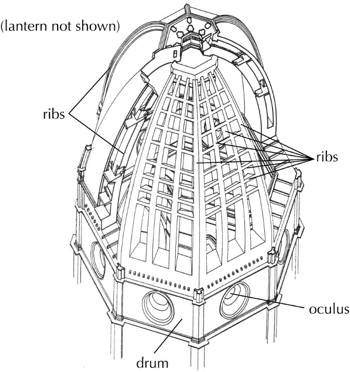
Cosimo becomes the patron for Filippo Brunelleschi when others see him as an eccentric. Brunelleschi certainly exhibits his difficult personality as evidenced by his being thrown out of the political house and also his reaction to losing the baptistery door competition. Ghiberti submits an excellent example of the international style for the judges (one judge is Giovanni de’Medici) to view during the baptistery door competition. The competition was open to artists all across the region and Filippo Brunelleschi submitted a very forward-thinking sculpture to the judging panel as well. In the end, the judges deemed both to be extraordinary submissions, but gave the nod to the veteran sculptor Ghiberti. To appease Brunelleschi, the judges propose that both he and Ghiberti work together to complete this very important commission for the baptistery doors of the Florence cathedral. Brunelleschi, still hurting from the decision the judges made favoring Ghiberti, refused this offer stating that two geniuses cannot work successfully together on one commission.
Shortly after this disappointment, Cosimo proposes to Brunelleschi that he complete the dome of the Florence cathedral. The two of them travel to Rome and Brunelleschi is able to see firsthand the Pantheon built by the ancient Romans. He is able to see that the dome is actually constructed in two layers of poured concrete. Looking back at the Florence cathedral, and considering how he can adapt this technology, he concludes that one: there isn’t enough wood in all of Tuscany to build a form to pour the concrete, and two: the formula for that type of concrete no longer exists. He then goes to work to figure out what will work, given the materials and the technology available to him at that time. What he designs shows just how much of a genius he is. He adopts the double-layer building technique of the ancient Romans, but he uses a specific herringbone pattern of laying bricks to maintain the stability needed to traverse such a wide space across the diameter of the dome. Using both horizontal and vertical stone ribs and filling in between with the herringbone brick work, he is able to solve the riddle of the dome. This is something that no other individual was able to do for decades. What he did, with the unfailing support of Cosimo is quite spectacular. Someone calling it a miracle. This was very important for the people of Florence, for without a dome, the Florence cathedral could not be sanctified (since it was open to the elements). Once the dome was completed, the Florence cathedral could function as the major religious center and point of pride for the people of Florence. The dome itself dominates the geographic area by its sheer size and quickly becomes the new symbol of Florence ingenuity and skill.
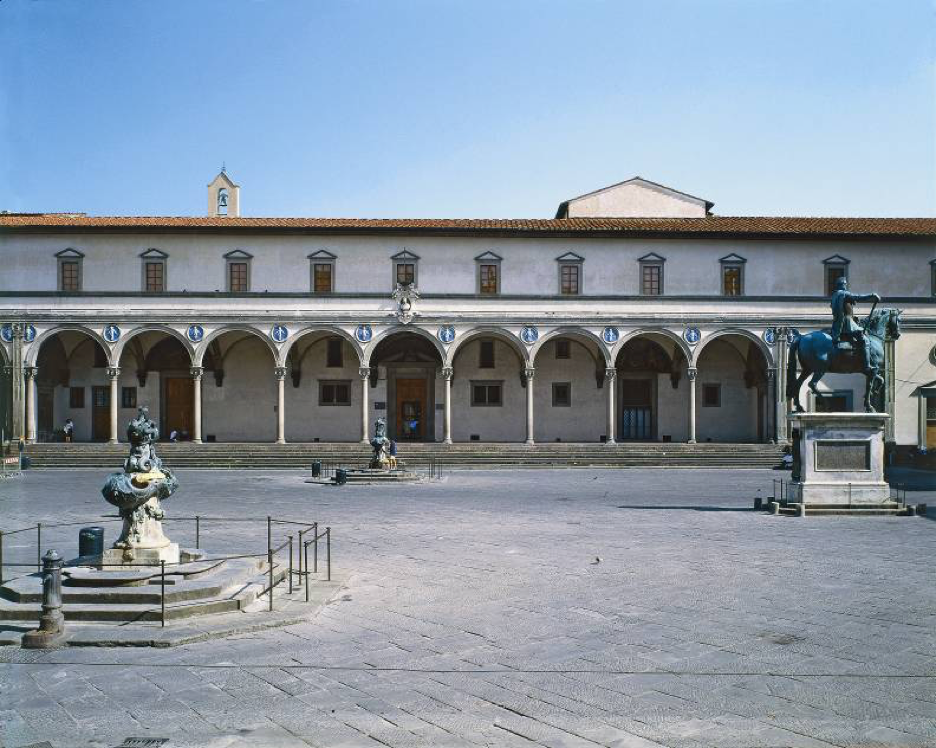
Hospital of the Innocents, Florence begun 1421 Filippo Brunelleschi
Brunelleschi also worked public projects sponsored by the guilds of Florence. The hospital for orphans was sponsored by the Guild of Silk Manufacturers and Goldsmiths. In this design we see Brunelleschi using classic ratios and supporting columns. The design is balanced and without the ornamentation of the earlier Gothic architecture. By studying ancient Roman buildings, he was able to uncover and solve questions about ancient Greek design architectural design systems. Since Roman buildings were based on the Greek classical orders of architecture, studying these buildings allowed him to peer into the past and begin applying what her learned.
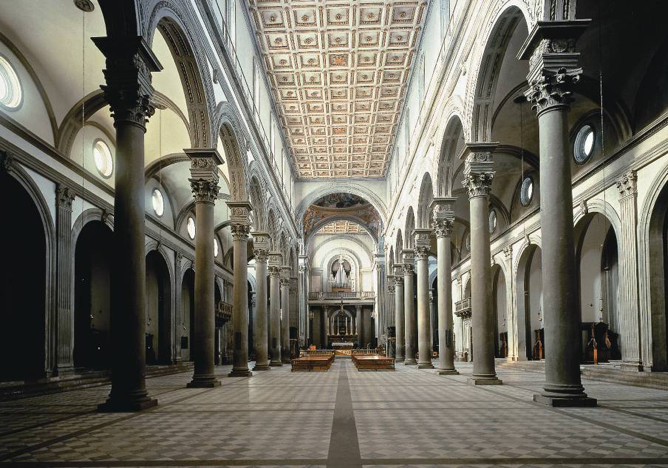
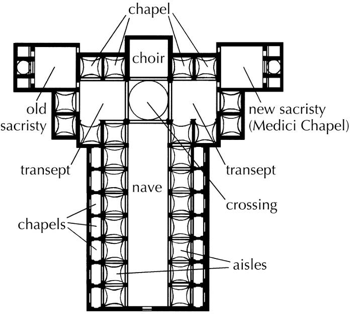
Church of San Lorenzo, Florence 1421-69 Brunelleschi
The Medici family commissioned Brunelleschi to add a sacristy to the church of San Lorenzo. This will be known as the Medici chapel, or new sacristy. The Medici family was so pleased with the result that they commissioned Brunelleschi to redesign the entire church. The redesign moves away from the Gothic style and presents as a classical architectural building on the inside. Corinthian columns, a favorite of the Romans, support classical arches. There is an elegant and simple balance in the design that departs from the earlier Medieval European architectural designs.
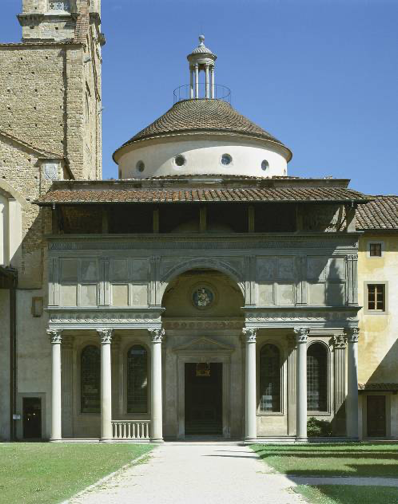
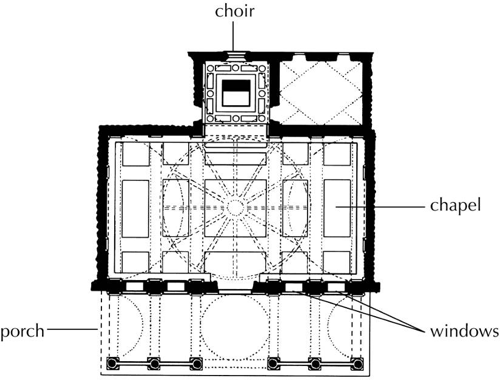
Capella dei Pazzi 1430s
Designed for the powerful Pazzi family of Florence, Brunelleschi designed a central plan chapel with classical proportions. The porch, added later, may not have been part of this original design.
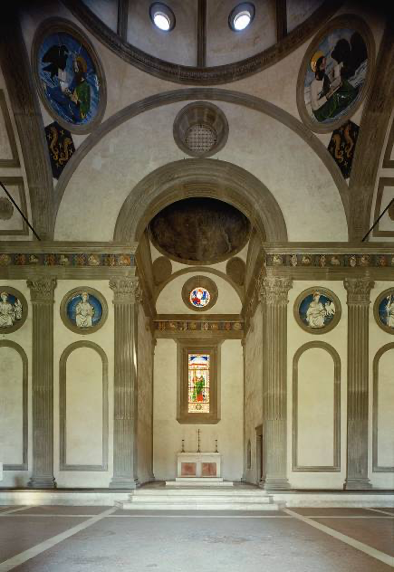
Pazzi Chapel Interior
Brunelleschi will achieve much more than the completion of the Florence cathedral dome during his lifetime. He helps bring back classical proportions to architectural projects in Florence. His redesigns and new designs use weight-bearing columns and arches not really seen since Roman antiquity. The grace in simple proportions of his designs usher in a new style that moves away from the ornate Gothic. It appears very fresh and new and in keeping with the ideals found in protagonists of the early renaissance period. Add to this is work in the field of mathematical linear perspective also known as vanishing point perspective, any emerges as one of the great minds of the renaissance. Linking art to math and science allows fine arts to enter the university as a field of study.
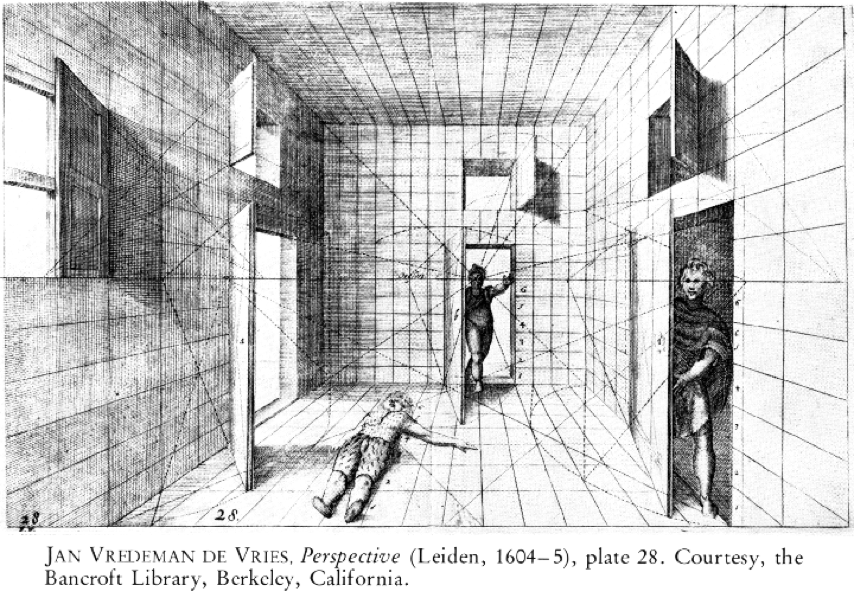
Alberti credits Brunelleschi with Perspective

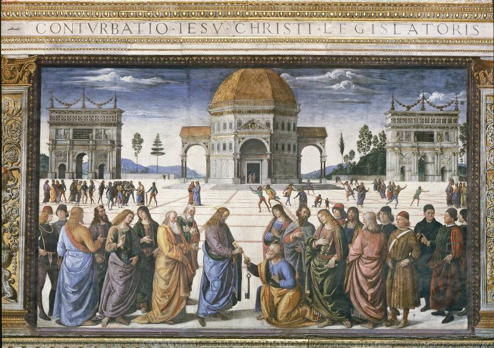
The Delivery of the Keys, Sistine Chapel, Vatican Palace, Rome, Pietro Perugino 1482
Alberti credits Brunelleschi with the discovery (or re-discovery?) of mathematical linear perspective, a technique for artists to represent the three-dimensional world in two-dimensional surfaces. This revolutionizes drawing and painting by helping artists to create paintings with authenticity. Renaissance painters will become obsessed with creating the illusion of realistic interior and exterior spaces that look convincingly real.
https://www.youtube.com/watch?v=_IOPlGPQPuM
https://www.youtube.com/watch?v=hOzyXQMvLPo
Renaissance in the North?
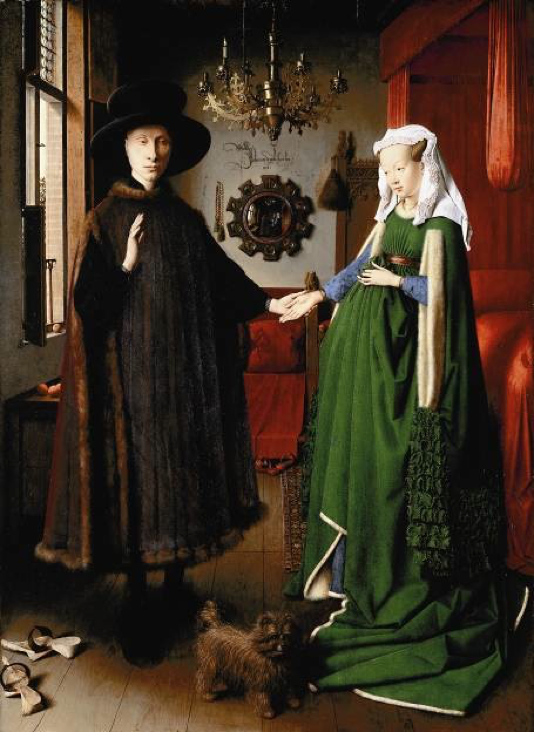
Arnolfini Portrait, Jan Van Eyck 1434
The study of art through time often creates challenges. One such conundrum is how knowledge of linear perspective travelled so quickly from Italy to the Netherlands. Jan Van Eyck correctly applies one-point perspective in the above painting at a time Brunelleschi in Italy is rediscovering (or discovering) this drawing technique for representing three-dimensional form on a two-dimensional surface.
Jan van Eyck, painting in the style of the northern realists, achieves an unparalleled level of painting excellence. Using both proper perspective, and attention to detail including proper proportion of figures as well as color balance in the paintings, he achieves what no other northern artist had accomplished to that point in history. With the aid of the new painting technology gained by using oil as a flowing medium for painting, he achieves brilliant clarity, realism, and rich, vivid colors in his paintings. Jan van Eyck helps ushers is in a new tradition in painting for Northern artists that will last for generations.
https://www.youtube.com/watch?v=VMJK1EDG2X8
https://www.youtube.com/watch?v=iZNvYvxetoo
https://www.youtube.com/watch?v=bHxu6az9gVI
https://www.youtube.com/watch?v=n6mBdpPYDDQ
Donatello
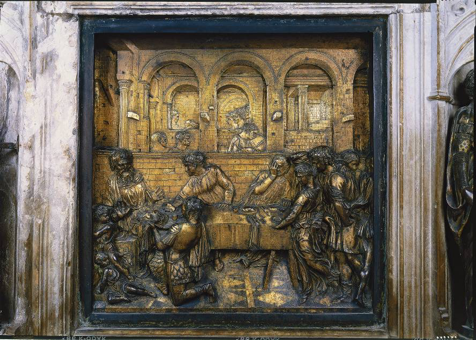
The Head of John the Baptist Presented to Herod
The partnership between Cosimo de’Medici and Donatello is one that goes beyond patron an artist since they really were friends. Donatello also had a difficult personality exhibiting anger when he felt slighted by patron. He was known to destroy his work rather than deliver it to an unappreciative client. Donatello certainly had his detractors, but Cosmo de Medici would step up to defend his friend and to let others know that he is still friends with Donatello. Cosimo and Donatello create a work that is quite daring for the time. The peace itself, is quite erotic and could’ve been problematic for both parties. The piece I’m talking about is David by Donatello. It is a quite sensual piece that can be viewed as erotic as well. The David is portrayed as a young man in the nude and standing over the head of the defeated Goliath. Even the feathers that are depicted running up to the thigh of David could be viewed as an erotic caress. Florence at times was quite liberal with a large population of homosexuals. There were many men who were tried for side of Mia during the renaissance. It was considered a serious crime punishable by death so what they were doing was quite risky. What is the work commission by the Medicis what is displayed within their palace, so that would be a limited group who would actually see some of the sculptures and paintings commission by the family. David itself is one of several firsts that Donatello will create during his lifetime. This is the first life-size nude bronze since antiquity. The cast in bronze, is quite an expensive endeavor and having the financial support of Cosimo de Medici as well as the creative license must’ve been a great asset for Donatello.
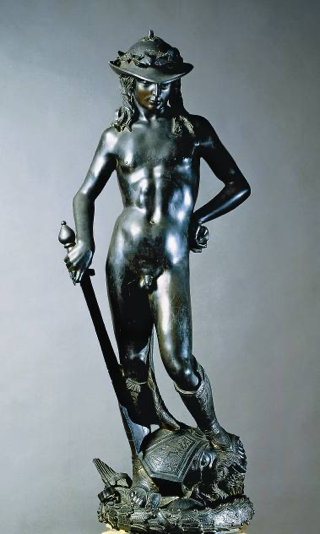
Donatello and the first life size nude since antiquity (the David)
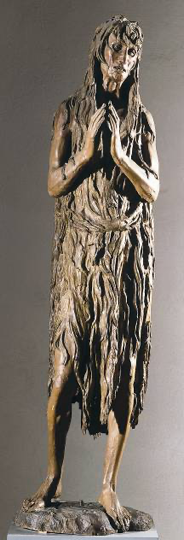
Mary Magdalene, Donatello
Donatello goes on to create other masterpieces that help to bring back knowledge of the human figure for use in sculpture. His use of contrapposto is exceptional. Donatello studied in the studio of Ghiberti and the two eventually became competitors. Ghiberti was an exceptional sculptor, and Donatello exceeds his mentors work in many ways. Another first that Donatello gives us is the first life-size equestrian statue since antiquity. Once again cast in bronze, this is a major commission and achievement during this time. Each time Donatello reaches a new mile stone, he pushes the renaissance forward setting a high bar for those artists who will come after him. Donatello shows us his versatility when he scopes Mary Magdalene out of wood, she is covered by her long hair that flows around her like a ragged garment. His sensitivity and empathetic approach to Mary Magdalene tells much about who he is as a human. It is quite an emotional work of art that is moving. It tells a visual story of suffering and resilience of a woman devoted to the teachings of Christ.
https://www.metmuseum.org/toah/hd/dona/hd_dona.htm
https://www.youtube.com/watch?v=vcoRoP3Abt8
https://www.smithsonianmag.com/smart-news/donatello-renaissance-art-history-180979774/
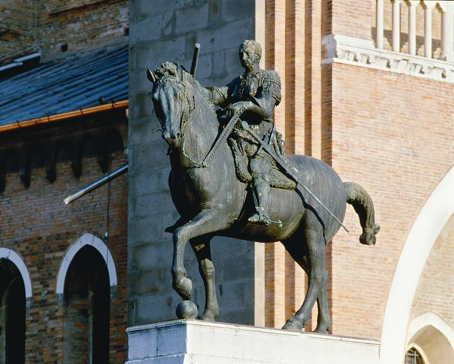
First life-sized equestrian statue
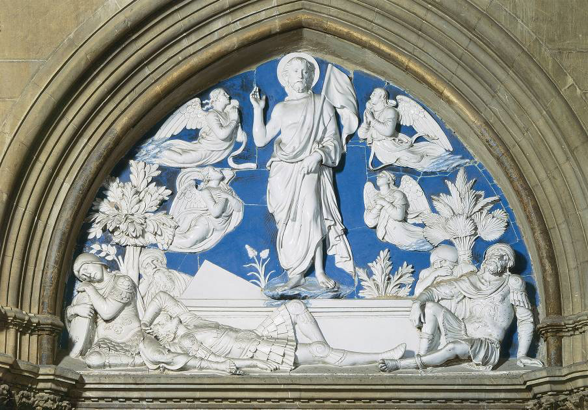
Luca della Robbia
Luca della Robbia was an Italian Renaissance sculptor from Florence. Della Robbia is noted for his colorful, tin-glazed terracotta statuary, a technique that he invented and passed on to his nephew Andrea della Robbia and great-nephews Giovanni della Robbia and Girolamo della Robbia.
http://www.iitaly.org/magazine/focus/art-culture/article/della-robbia-comes-washington-dc
https://www.mfa.org/exhibitions/della-robbia
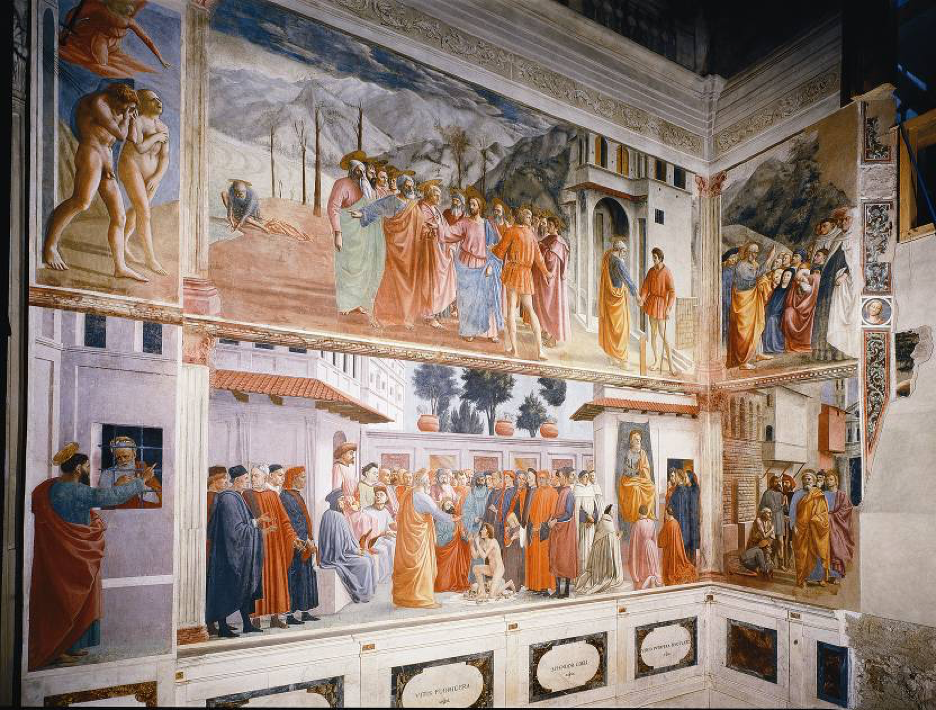
Massacio 1425
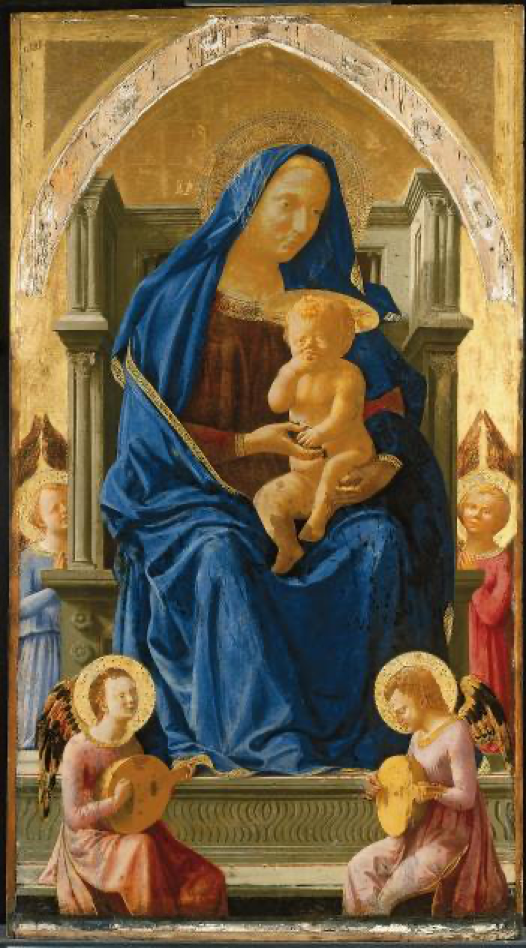
Massacio 1426
Massacio is an important painter and link between the Italian painters of the 14th century like Giotto and the Renaissance painters to follow. We begin to see more naturalism, proper use of perspective, and improved modeling of the forms in his paintings. Masaccio, born Tommaso di Ser Giovanni di Simone, was a Florentine artist who is regarded as the first great Italian painter of the Quattrocento period of the Italian Renaissance.
https://www.nga.gov/collection/artist-info.1688.html
https://www.nationalgallery.org.uk/artists/masaccio
https://www.nga.gov/audio-video/video/empire-part-2.html
https://www.youtube.com/watch?v=G6A9Mg3yAu0
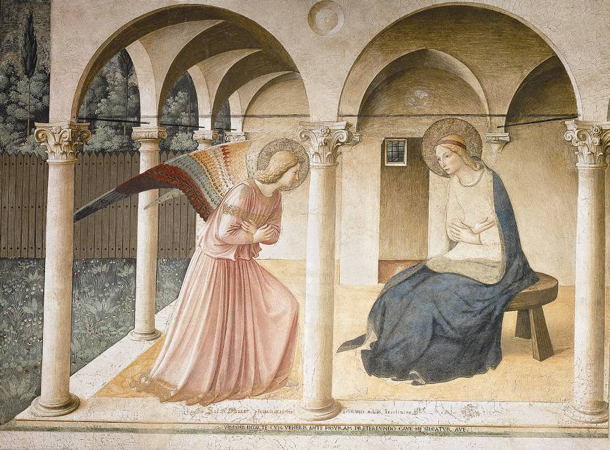
Annunciation, Fra Angelico 1440-1445

Madonna and Child with the Birth of the Virgin, Fra Filippo Lippi 1452-1453
Fra’ Filippo Lippi is another fascinating story and another example of a successful artist benefitting from the financial support of Cosimo de’Medici. Although Kosovo had to imprison lippy for a time, he still was able to extract superior work from this gifted painter. Lippy had a difficult life, being orphaned at an early age and having to live in the Carmelite monastery. He created some beautiful work for several different patrons over the years including work for the churches of the region. Almost constantly in trouble, he was also in a state of poverty for much of his life.
https://www.youtube.com/watch?v=Ly2-n1KqNko
Verrocchio

Lorenzo the Magnificent Verrocchio Studio (1480): Uses wealth to further the brand, even on an international stage.
https://www.nga.gov/audio-video/video/verrocchio-long.html
https://www.nga.gov/audio-video/video/verrocchio-butterfield.html
Boticelli
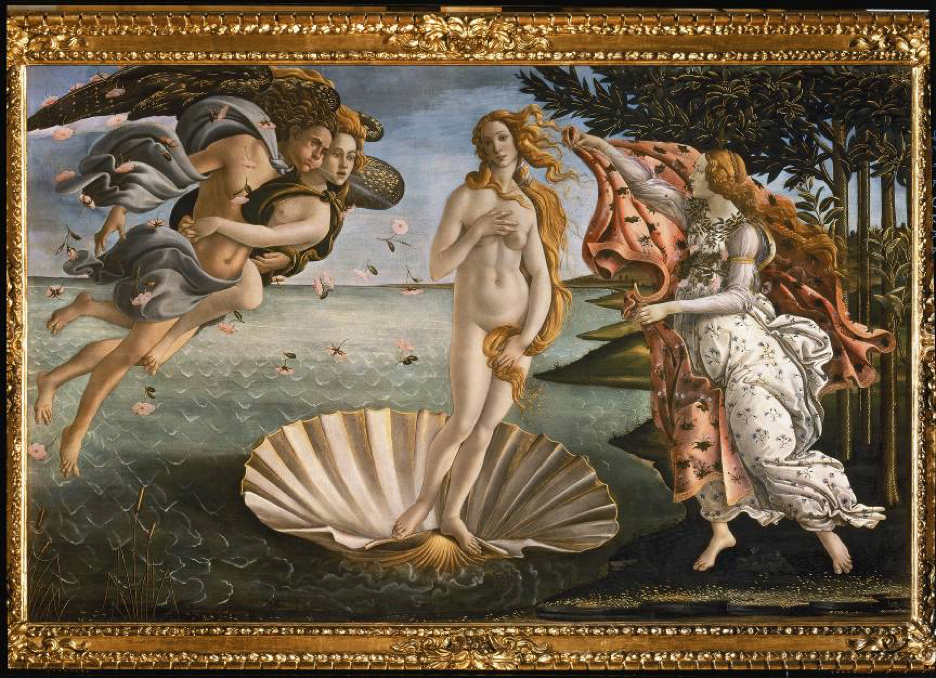
The Birth of Venus, Sandro Botticelli, 1480
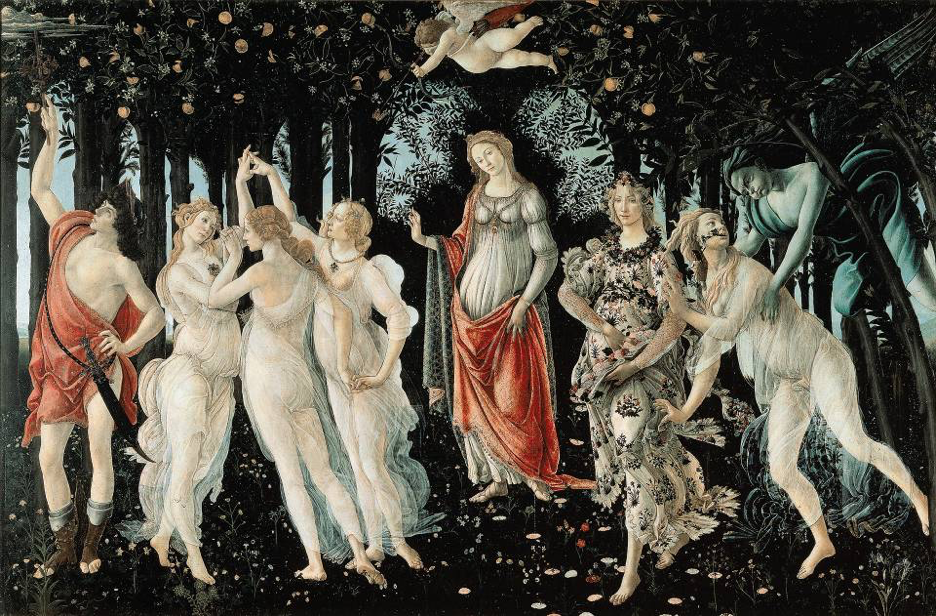
Primavera, Sandro Botticelli, 1482
Lorenzo de’Medici was given the distinction of being Lorenzo the magnificent. He was the grandson of Cosmo and upon the passing of his father he had to take over the Medici bank with all of the responsibilities that title held. Lorenzo was the patron of several great artists of the renaissance. He funneled incredible amounts of money into art commissions to further the Medici brand as well as to establish the Medici not only on the local and regional level but on the world stage as well. He funded the travels of people from far of lands to come and see for themselves the grandeur of the Medici. While still in his teens, Michelangelo came to live with Lorenzo de’Medici and his family and then doing so learn quite a bit about ancient writers, sculptors, and culture. Lorenzo saw in Michelangelo a troubled youth of great ability and drive. He encouraged Michelangelo, and helped him develop his art skills as a sculptor. Having these connections with the Medici family helped Michelangelo politically as the years went on since the boys Michelangelo grew up with eventually became Roman Catholic popes.
Lorenzo also partners with Sandro Botticelli. Again, allowing his artists to explore dangerous subject matter, Botticelli creates paintings that merge Christian and pagan themes. These paintings were meant for the private enjoyment by the Medicis, and not for public consumption. The Birth of Venus of 1480 and Primaveraof 1482 are great examples of the merging of these two worlds by Botticelli. We can see in the tilt of Venus’s head echoes of the Byzantine Madonna, yet this Venus/Madonna is placed in a mythological world. Paintings like this, as well as the earlier David by Donatello, really push the envelope of what is acceptable. In terms of painting technique, we find that Botticelli uses a hard edge for the figures and forms represented in his paintings. This continues similar painting techniques seen earlier in the works of Fra’ Lippi.
Lorenzo de’Medici is the intended target of an Easter Sunday assassination attempt in the Florence Cathedral by the Pazzi family in coordination with the Roman Catholic Church. The church was heavily indebted to the Medici family and the Pazzi family would certainly benefit from removing the Medici from Florentine power. The attempt on Lorenzo failed, although he was wounded. However, his beloved brother Juliano was assassinated. Not long after this, his wife passed away and Lorenzo was never quite the same. As his health failed, another Florentine figure rose to power and challenged all that Lorenzo and his forbearers had built. A fanatical Dominican Friar named Savonarola who denounced secular art and culture pushed for religious renewal in Florence. Savonarola did not support the endeavors and excesses of Lorenzo’s lifestyle. While on his deathbed Savonarola was summoned and condemned Lorenzo to hell when Lorenzo was asking for absolution. This must’ve been devastating to Lorenzo who believed in receiving final rights and absolution before death. Once Lorenzo had passed, the door was open for Savonarola to enforce his culture war. Sending out radicalized youth to enforce new rules on jewelry, makeup, clothing, and art he changed the climate of the city. He organized a large event where people of Florence discarded the symbols of their wealth into a large fire. Even Botticelli threw paintings into the fire. This event became known as the Bonfire of the Vanities and almost ended the Renaissance movement forcing Florence back to the mentality of the middle ages. Fortunately, Savonarola’s brutal form of religion for the lives of Florentines was short-lived. He was summoned back to Rome, he refused, and was branded a heretic and executed and his body was burned as well.
https://www.youtube.com/watch?v=cdQu3cOOaWE
https://www.youtube.com/watch?v=jNkHq6QXX30
https://www.youtube.com/watch?v=GUb4SeGWvtM
https://www.youtube.com/watch?v=O_4HA9TrIvE
https://www.youtube.com/watch?v=tcjeSMICLz0
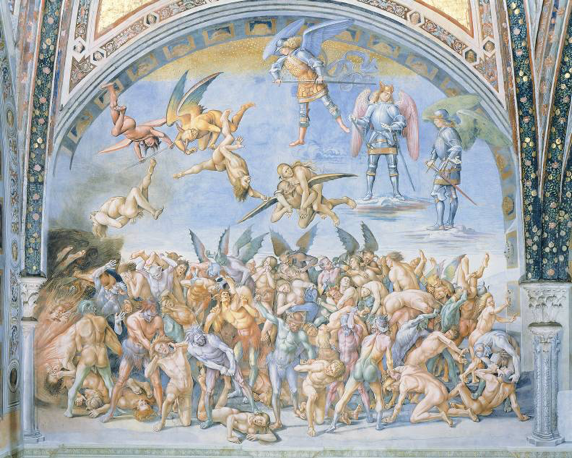
The Damned Cast into Hell 1499-1500 San Brizio Chapel, Orvieto, Luca Signorelli
https://www.nga.gov/collection/artist-info.1874.html
Alberti

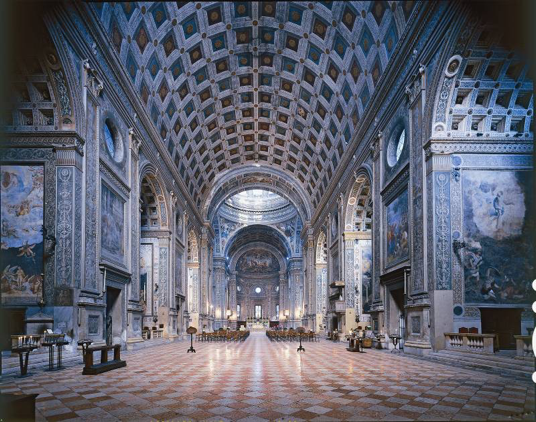
Church of Sant’ Andrea, Mantua, designed in 1470 Bautista Alberti (1404-1472)
Alberti was a gifted and imaginative architect who also wrote Treatises on the arts. He would later influence architects like Palladio who shared his interest in classical forms. What Alberti accomplishes with his church in Mantua is extraordinary in both vision and execution. It is a massive church in size and scale, but more impressive is the integration of external design elements with the interior. The design of the façade reflects what is seen within. A massive arched entry, encompassing three stories, greets the congregant. Faux columns (pilasters) of two and three-story heights flank the entry arch. A giant pediment sits atop the façade completing the symmetrical classical design. The design does not fit any of the three classical orders of architecture. It is neither Doric, Ionic, or Corinthian. It is now termed the Colossal Order, a term meaning it is more than one story high. It merges classical temple forms with the traditional basilica church. Alberti also uses the geometric shape of a square to help unify the façade. The effect is dramatic, in this, Alberti’s last design.
Early Renaissance in Venice
As Rome became the center of an imperial papal style of art, Venice endured the enmity of its neighbors and the dismantling of its northern Italian Empire. Having gradually expanded its influence over northeastern Italy in 1509 the Republic of Venice faced a threat from the League of Cambria, an international military alliance aimed against it. Yet, by 1529, Venice had outlasted this menace to its power and reclaimed most of its lost territory. Resisting the invasions of Europe by the Turks, Venice’s Navy fought determinedly in the Eastern Mediterranean to hold off this threat. Amid this turmoil, artists in Venice built on the traditions of the 15th century and the innovations of Giovanni Bellini. To create a distinct visual language, two artists in particular, Giorgione and Titian, created new subjects, approaches to images, and techniques in the next art period to come, the High Renaissance.
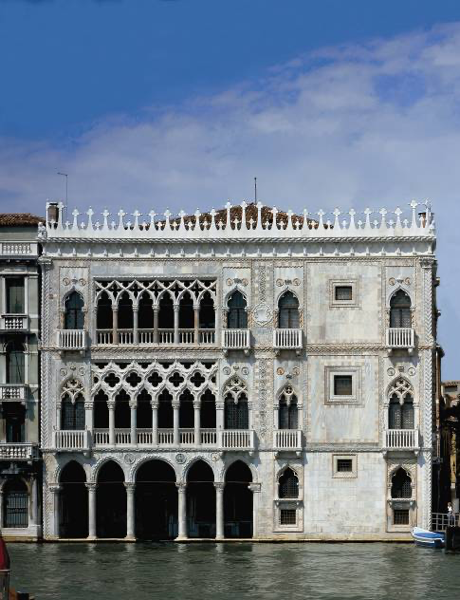
Ca’d’Oro, Venice 1422-1440
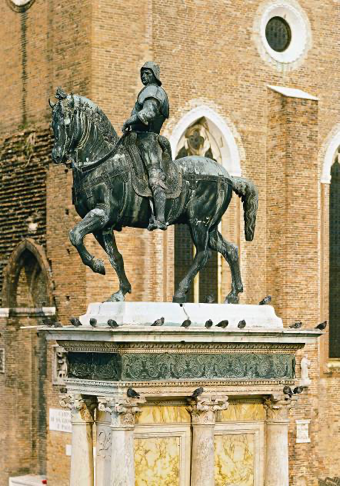
Equestrian Monument of Colleoni Andrea del Verrocchio (1483-1488)
Venetian architecture combines aspects of Gothic, classical forms, and Islamic influences to create a unique language. Ca’d’Oro is an excellent example of this unique style. We also see major commissions to honor military leaders such as Colleoni. Colleoni left a large sum of money to finance a sculpture of himself. Verrocchio’s studio completed the work taking inspiration from Donatello’s Gattamelata. There are, however, a few differences such as the size of the rider. Verrocchio allows Colleoni to appear larger in relation to his horse making him appear powerful.
https://www.wmf.org/project/bartolomeo-colleoni-monument
Bellini
In Venice, use of oil as a painting medium enhanced and advanced the art of the region. Venetian painters become known for their rich, vibrant color palettes and their exquisite use of space in their compositions.
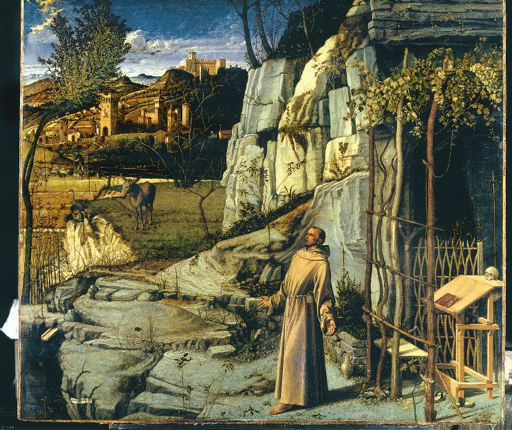
St. Francis in Ecstasy Giovanni Bellini 1480

Madonna and Saints, San Zaccaria, Venice, Bellini 1505
What we see in the Venetian painters of the late 15th century is use of oil paints as a painting medium. This was a technique imported from Flanders and immediately made an impact on the vibrancy of the colors in Venetian paintings. Combine this with Italian techniques of composition, use of space and perspective, and beautiful lighting and you have some of the most rich and significant paintings of the period. Bellini will lead Venice in a new direction and be the father of Venetian painting.
https://www.youtube.com/watch?v=LO8M3Aiat90


